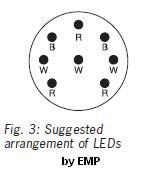Here is a signal lamp for safe highway driving.
The lamp automatically emits brilliant tricolour light when a
vehicle approaches the rear side of your vehicle. It emits
light for 30 seconds that turns off when the approaching
vehicle overtakes.
The Components needed to prepare this
light to alert the approaching vehicle’s driver even during the day,
giving additional safety during night, or when you need to stop your vehicle
on side of the highway. The circuit saves considerable battery power.
The circuit is built around two timer ICs NE555 (IC1 and IC2). IC1 is designed
as a standard monostable, while IC2 is designed as an astable. Darlington
phototransistor L14F1 (T1) is used as a photosensor to activate the monostable.
The collector of phototransistor T1 is connect to trigger pin 2 of IC1, which is
normally kept high by resistor R1.
When headlight from an approaching vehicle illuminates the phototransistor, it conducts to
give a short pulse to IC1, and the output of IC1 goes high for a period determined
by resistor R2 and capacitor C1. The output of IC1 is fed to the base of transistor
T2 via resistor R3. Transistor T2 conducts to drive transistor T3 and its collector goes
high to take reset pin 4 of IC2 to high level. This activates astable IC2, which
switches on and off the LED chain alternately.
The intermittent flashing of LEDs gives a beautiful tricolour flashlight effect.
The circuit can be easily constructed on a small piece of general-purpose PCB. Fig.
2 shows the bottom and front views of Darlington phototransistor L14F1. The proposed
arrangement of LEDs, which are soldered in a circular fashion on a generalpurpose
PCB, is shown in Fig. 3. Use a circular reflector for the LEDs to get brighter
light. Fix the LED arrangement on the rear side of your vehicle, and the phototransistor
where it is illuminated directly by the headlight of the approaching vehicle. 12V DC
supply to the circuit, can be provided by your vehicle battery with proper polarity.
The lamp automatically emits brilliant tricolour light when a
vehicle approaches the rear side of your vehicle. It emits
light for 30 seconds that turns off when the approaching
vehicle overtakes.
The Components needed to prepare this
- IC555
- Transistor
- Resistor & capacitor
- LED (red), LED(blue)&;LED(white)
- Darlington phototransistor
light to alert the approaching vehicle’s driver even during the day,
giving additional safety during night, or when you need to stop your vehicle
on side of the highway. The circuit saves considerable battery power.
The circuit is built around two timer ICs NE555 (IC1 and IC2). IC1 is designed
as a standard monostable, while IC2 is designed as an astable. Darlington
phototransistor L14F1 (T1) is used as a photosensor to activate the monostable.
The collector of phototransistor T1 is connect to trigger pin 2 of IC1, which is
normally kept high by resistor R1.
When headlight from an approaching vehicle illuminates the phototransistor, it conducts to
give a short pulse to IC1, and the output of IC1 goes high for a period determined
by resistor R2 and capacitor C1. The output of IC1 is fed to the base of transistor
T2 via resistor R3. Transistor T2 conducts to drive transistor T3 and its collector goes
high to take reset pin 4 of IC2 to high level. This activates astable IC2, which
switches on and off the LED chain alternately.
The intermittent flashing of LEDs gives a beautiful tricolour flashlight effect.
The circuit can be easily constructed on a small piece of general-purpose PCB. Fig.
2 shows the bottom and front views of Darlington phototransistor L14F1. The proposed
arrangement of LEDs, which are soldered in a circular fashion on a generalpurpose
PCB, is shown in Fig. 3. Use a circular reflector for the LEDs to get brighter
light. Fix the LED arrangement on the rear side of your vehicle, and the phototransistor
where it is illuminated directly by the headlight of the approaching vehicle. 12V DC
supply to the circuit, can be provided by your vehicle battery with proper polarity.




plz send ppt of this project
ReplyDelete